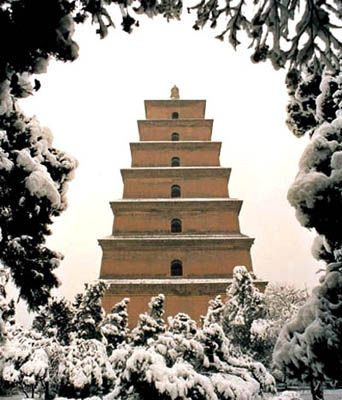|
The Great Wild Goose Pagoda is located in the Ci'en Temple (the Mercy and Favor Temple) about 4 kilometers away from the Hepingmen Gate of Xi'an City.

The Great Wild Goose Pagoda, formerly named the Pagoda of the Ci'en Temple or the Non-Leak Temple, was built in the Sui Dynasty (581-618). In the 21styear (647) of the Zhenguan reign of the Tang Dynasty, Prince Li Zhi expanded the temple in memory of his dead mother, Queen Wende, and then renamed this temple as the Grand Mercy and Favor Temple. In this temple, there are 1,897 pavilions, halls and monastic rooms. Many famous Chinese ancient painters such as Yan Liben, Yuchiyi Monk, Wu Daozi, and Yin Lin, etc., all once stayed there painting.
Shortly after the completion of the temple, famous monk Xuan Zang moved here from the Hongfu Temple for his script translation work. He stayed there for 19 years, completing the translation of 74 sutras, and setting upthe Ancestor of Mercy and Favor for Buddhismin this temple, so the temple won fame far and wide and received many worshipers. The Great Wild Goose Pagoda was established in the 3rdyear (652) of the Yonghui reign of the Tang Dynasty (618-907), when Li Zhi, Emperor Gaozong, built it to settle the Sutra Classics brought back by Monk Xuan Zang from India. Unfortunately, the temple was destroyed by war in the late Tang Dynasty, and all the halls are now in ruin, only with the pagoda still standing there. Today, all the extant architectures in the temple were rebuilt in the Ming and Qing dynasties (1368-1911).
The Great Wild Goose Pagoda had 5 layers at the beginning, a brick shell with earth core, and it was extended to 10 layers in reconstruction, but was reduced to 7 layers after the renovation in during the Chang'an reign (701-704) of Empress Wu Zetian, and became a pavilion-shaped pagoda in gray brick structure with a square plane. The pagoda consists of a base and a body, the base has an edge of 48 meters length and 4.2 meters height, and the pagoda body is 25 meters wide in each side and 59.9 meters tall. The total pagoda, including the base and the body is 64.1 meters high. Beside each wall of the pagoda body stand flat pillars and railings made of bricks. The pagoda has a square internal plane, and floors and stairs with handlings lead to the top of the pagoda. In the Ming Dynasty (1368-1644), a thick brick layer was reinforced at the outer wall of the pagoda.
|

